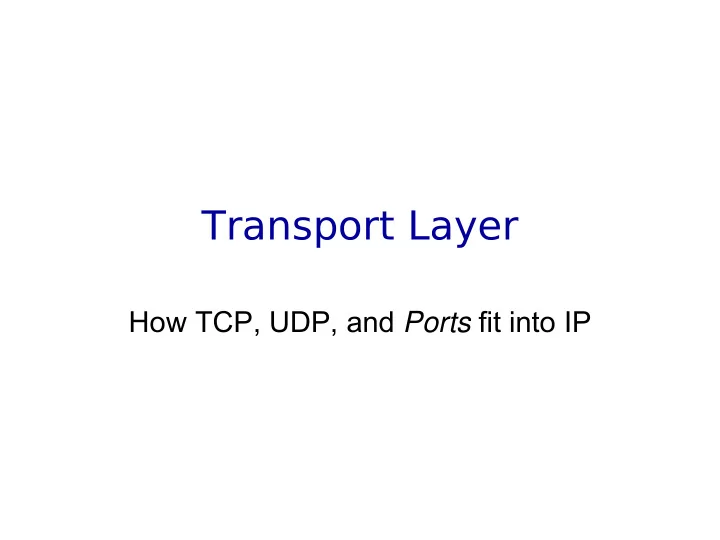

Transport Layer How TCP, UDP, and Ports fit into IP
Layer 4: the Transport Layer
Responsibilities and Services � Overall: message delivery � “End-to-end" communications between processes ( i.e. running programs) − Communicating processes may be on widely- separated network hosts, or on the same computer � Connection-oriented or Connectionless service � Reliable transport using checksums � Flow control (so hosts aren't overwhelmed)
Identifying the End Processes � Processes run on hosts that have IP addresses � Each (networking) process on the host is assigned a port � Combination of IP address and Port is called a network socket − Processes on the Internet are uniquely identified by their network sockets � Network sockets are an implementation of OSI-model's Service Access Points
Well-Known and Other Ports � Some ports are assigned to specific applications by common agreement − Ports, Protocol numbers, IP addresses, etc. were originally maintained by Jon Postel, and reported in "RFC" documents – RFC1700, October 1994, was the last � Goodbye, RFC 1700. Hello, IANA! − The I nternet A ssigned N umbers A uthority now assigns and registers numbers in a database � Well-known ports: 1-1023 � IANA Registered ports: 1024-49151
A Sampling of Port Numbers • As of March 19, 2009 • Registered ports: – Over 9000 ports have been registered… • IANA-assigned ("Well-Known") ports: ftp-data 20 /tcp File Transfer [Default Data] remote-as 1053 /tcp Remote Assistant (RA) ftp-data 20 /udp File Transfer [Default Data] remote-as 1053 /udp Remote Assistant (RA) ftp 21 /tcp File Transfer [Control] estamp 1982 /tcp Evidentiary Timestamp ftp 21 /udp File Transfer [Control] estamp 1982 /udp Evidentiary Timestamp ssh 22 /tcp SSH Remote Login Protocol xbox 3074 /tcp Xbox game port ssh 22 /udp SSH Remote Login Protocol xbox 3074 /udp Xbox game port smtp 25 /tcp Simple Mail Transfer ipfltbcst 4068 /tcp IP Fleet Broadcast smtp 25 /udp Simple Mail Transfer ipfltbcst 4068 /udp IP Fleet Broadcast http 80 /tcp World Wide Web HTTP # Trung Huu Tran <trung.tran&navy.mil> March 2007 http 80 /udp World Wide Web HTTP freeciv 5556 /tcp Freeciv gameplay newacct 100 /tcp [unauthorized use] freeciv 5556 /udp Freeciv gameplay bgp 179 /tcp Border Gateway Protocol asr 7800 /tcp Apple Software Restore bgp 179 /udp Border Gateway Protocol asr 7800 /udp Apple Software Restore netware-ip 396 /tcp Novell Netware over IP gamesmith-port 31765 /tcp GameSmith Port netware-ip 396 /udp Novell Netware over IP gamesmith-port 31765 /udp GameSmith Port https 443 /tcp http protocol over TLS/SSL https 443 /udp http protocol over TLS/SSL philips-vc 583 /tcp Philips Video-Conferencing philips-vc 583 /udp Philips Video-Conferencing • Dynamic and/or Private ports: soap-beep 605 /tcp SOAP over BEEP – The Dynamic and/or Private Ports are those from 49152 soap-beep 605 /udp SOAP over BEEP through 65535 rsync 873 /tcp rsync – The registered ports can also be used as dynamic ports, rsync 873 /udp as long as the communicating hosts aren't using a rsync conflicting registered service 1023 /tcp Reserved 1023 /udp Reserved
Transport-Protocol Data Units � TCP/IP: primary protocols are UDP , TCP − SCTP, UDP-Lite are newer protocols − IP headers (layer 3) include information about the TCP/UDP (layer-4) PDUs � U ser D atagram P rotocol: individual datagrams without guaranteed delivery � T ransport C ontrol P rotocol: divides application data streams into segments based on lower layer constraints − E.g. , no more than 1448 application-data bytes per Ethernet frame
Transport Layer and Network Layer � Layer 3, the Network layer, routes the data across the Internet − IP is the most common layer-3 protocol − Novell's IPX is another � IP packets consist of header fields that do the layer-3 work, and a payload � Payload can be − a layer-3 management packet − a layer-4 packet � ( Transport Protocol Data Unit or T-PDU)
the IP header � IHL field specifies header length (in 32-bit words) − Optional fields – 32 bits per field – are seldom used � Total-Length field specifies datagram's length � Protocol field specifies payload type
Transport-layer Protocol Headers � IP's total length, minus IHL (IP header length), determines payload (T-PDU) size − UDP includes its own length field − TCP length depends on IP total length
UDP – User Datagram Protocol � Connectionless transport � Four 2-byte fields in header − Source port, Destination port; length and checksum of header, payload, & some IP fields � 0 – 65528 bytes of payload
Some Applications Using UDP � Source: www.tcpipguide.com/free/t_UDPCommonA pplicationsandServerPortAssignments- 3.htm
TCP – Transport Control Protocol � Connection-oriented transport � 3-way handshake uses SYN, ACK flags to negotiate a comm's channel � Sequence, acknowledgment numbers allow long payloads to be split into segments
TCP – the 3-way Handshake “SYN” and “ACK” flags � These flags are fields within the TCP header. A TCP packet may contain a payload − as well as the flags, or may carry only the flags and no payload. First: SYN – Synchronize flag � The “caller” sends a packet that requests a connection. − Details such as maximum packet size are included. − No payload, header fields only. − Second: SYN-ACK – SYN flag and Acknowledge flags, combined � The “recipient” (generally a server) sends a single packet containing an ACK of − the SYN, along with a SYN of its own. No payload in this packet either. − Third: ACK – "caller" acknowledges the returned SYN � The “caller” acknowledges the server's SYN with an ACK. The handshake is − completed. There could be a payload in this packet, but often there isn't any. −
Some Applications Using TCP Source: www.tcpipguide.com/free/t_UDPCommonApplicationsandServerPortAssignments-3.htm
Some Protocols that Aren't Transport-Layer • ICMP – Echo request, reply (Ping) • ARP – request, reply
end of Network Layer Protocols
Recommend
More recommend